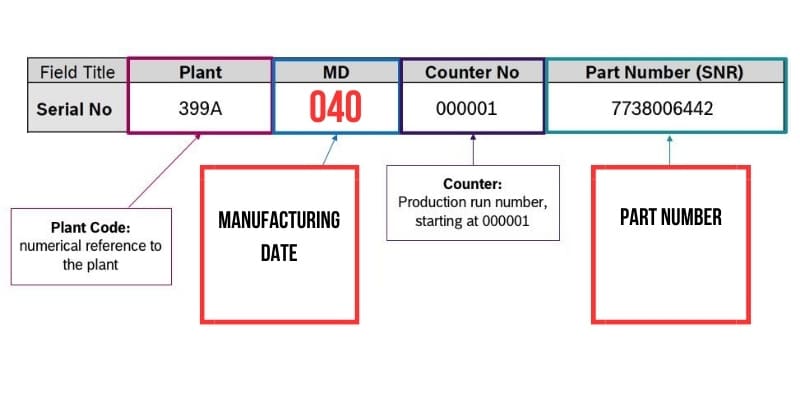HVAC has become integral to our daily lives, making tasks more convenient and efficient. However, like all things, they have a finite lifespan, and knowing the age of your Bosch heat pump or air conditioner unit is crucial for maintenance, repairs, and even replacements. This article aims to unravel the mystery behind Bosch serial numbers and provide a comprehensive guide to decoding the manufactured date.
Serial numbers are like unique fingerprints for appliances. They are vital identifiers, helping manufacturers track production, distribution, and warranty information. Regarding Bosch, these serial numbers pack a wealth of information beyond identifying the model.
Bosch Serial Number Lookup
Bosch serial numbers may seem like a jumble of letters and numbers. Still, they follow a specific pattern that holds the key to unveiling the HVAC’s age.

Let’s break it down:
- The first four digits represent the manufacturing plant where the appliance was made.
- The next three digits indicate the manufacturing date, with the first digit representing the year and the next two showing the month of production.
- The last ten digits indicate part number (SNR). This information is beneficial if you are looking for parts replacement.
Decoding the Manufacturing Date
Here are some examples of Bosch serial numbers, with the three-digit date code shown underlined:
- 399A-760-000031-8733942691 (Manufacture Date: 720)
- 35201730001497738007220 (Manufacture Date: 173)
- 35201800000027738007319 (Manufacture Date: 180)
- 3520-175-0000289-7738007421 (Manufacture Date: 278)
To find the month and year that the product was manufactured, match your three-digit date code with the table below:
| Jan | Feb | Mar | Apr | May | Jun | Jul | Aug | Sep | Oct | Nov | Dec | |
|---|---|---|---|---|---|---|---|---|---|---|---|---|
| 2010 | 001 | 002 | 003 | 004 | 005 | 006 | 007 | 008 | 009 | 010 | 011 | 012 |
| 2011 | 101 | 102 | 103 | 104 | 105 | 106 | 107 | 108 | 109 | 110 | 111 | 112 |
| 2012 | 201 | 202 | 203 | 204 | 205 | 206 | 207 | 208 | 209 | 210 | 211 | 212 |
| 2013 | 301 | 302 | 303 | 304 | 305 | 306 | 307 | 308 | 309 | 310 | 311 | 312 |
| 2014 | 417 | 418 | 419 | 420 | 453 | 454 | 455 | 456 | 457 | 458 | 459 | 460 |
| 2015 | 517 | 518 | 519 | 520 | 553 | 554 | 555 | 556 | 557 | 558 | 559 | 560 |
| 2016 | 617 | 618 | 619 | 620 | 653 | 654 | 655 | 656 | 657 | 658 | 659 | 660 |
| 2017 | 717 | 718 | 719 | 720 | 753 | 754 | 755 | 756 | 757 | 758 | 759 | 760 |
| 2018 | 817 | 818 | 819 | 820 | 853 | 854 | 855 | 856 | 857 | 858 | 859 | 860 |
| 2019 | 917 | 918 | 919 | 920 | 953 | 954 | 955 | 956 | 957 | 958 | 959 | 960 |
| 2020 | 037 | 038 | 039 | 040 | 073 | 074 | 075 | 076 | 077 | 078 | 079 | 080 |
| 2021 | 137 | 138 | 139 | 140 | 173 | 174 | 175 | 176 | 177 | 178 | 179 | 180 |
| 2022 | 237 | 238 | 239 | 240 | 273 | 274 | 275 | 276 | 277 | 278 | 279 | 280 |
| 2023 | 337 | 338 | 339 | 340 | 373 | 374 | 375 | 376 | 377 | 378 | 379 | 380 |
| 2024 | 437 | 438 | 439 | 440 | 473 | 474 | 475 | 476 | 477 | 478 | 479 | 480 |
| 2025 | 537 | 538 | 539 | 540 | 573 | 574 | 575 | 576 | 577 | 578 | 579 | 580 |
| 2026 | 637 | 638 | 639 | 640 | 673 | 674 | 675 | 676 | 677 | 678 | 679 | 680 |
| 2027 | 737 | 738 | 739 | 740 | 773 | 774 | 775 | 776 | 777 | 778 | 779 | 780 |
| 2028 | 837 | 838 | 839 | 840 | 873 | 874 | 875 | 876 | 877 | 878 | 879 | 880 |
| 2029 | 937 | 938 | 939 | 940 | 973 | 974 | 975 | 976 | 977 | 978 | 979 | 980 |
| 2030 | 0A1 | 0A2 | 0A3 | 0A4 | 0A5 | 0A6 | 0A7 | 0A8 | 0A9 | 0AA | 0AB | 0AC |
These serial numbers provide insights into the manufacturing date of the appliances. The date code is usually the three digits that represent the year and week of production. Understanding this date code allows you to determine the approximate age of your Bosch HVAC and make informed decisions about maintenance and repairs.
For example, suppose you determine that your HVAC unit was manufactured in 2016 and shows signs of wear in 2023. In that case, consider investing in maintenance or a replacement.
The age range of your Bosch can be a game-changer, especially when it comes to warranty coverage. Most warranties cover a specific period after the manufacturing date. You can determine if your air conditioner is still under warranty by identifying the manufacturing date through the serial number. This knowledge can save you money on potential repairs or replacements.
You can also identify where your unit was made by deciphering the serial number. This information can be valuable if you need to source replacement parts or require technical assistance.
Locating the Serial Number
Locating the serial number on your Bosch heat pump and air conditioner might seem like a treasure hunt. Still, it’s crucial for unlocking the valuable information it holds. The serial number is usually on the unit’s label or data tag.
For example, the serial number of the Bosch Split Systems air conditioner can be found on the rating plate located on the exterior front of both indoor and outdoor units.
In a Bosch heat pump split system, the serial number can be found on the rating label sticker located on the exterior front of the air handler and condenser sections.
Frequently Asked Questions
- Can the serial number help me determine the size of my Bosch air conditioner? No, the serial number primarily provides information about the manufacturing date, location, and age. To identify the tonnage, refer to the Bosch model number.
- What if I can’t locate the serial number on my Bosch air conditioner? If you need help finding the serial number, consult the user manual.
Tips for Maintenance and Longevity
A well-maintained air conditioner keeps your indoor space comfortable and ensures optimal performance and energy efficiency. If you own a Bosch air conditioner, here are some essential tips to help you maintain its functionality and extend its lifespan:
1. Regular Cleaning: Keep your air conditioner’s outdoor and indoor units clean from dirt, debris, and dust. Clean the outdoor condenser coils periodically using a soft brush or a gentle stream of water. Similarly, vacuum the indoor vents and filters to remove accumulated dust. Clean filters improve airflow and overall efficiency.
2. Check and Replace Filters: Filters are crucial in maintaining air quality and system efficiency. Check the filters monthly and replace or clean them as needed. Clogged filters restrict airflow, making the air conditioner work harder and consuming more energy.
3. Maintain Clear Surroundings: Ensure that the area around the outdoor unit is clear of obstructions such as plants, leaves, or debris. Proper airflow around the unit allows it to function efficiently. Keep a clear space of at least a few feet around the unit.
4. Inspect Wiring and Connections: Periodically inspect the wiring and connections for signs of wear, damage, or loose connections. Faulty wiring can lead to safety hazards and system malfunctions. If you notice any issues, contact a professional technician to address them.
5. Schedule Professional Maintenance: Consider scheduling an annual maintenance visit from a certified technician. A professional will perform thorough checks, clean the components, lubricate moving parts, and ensure the system operates at its best.
6. Monitor Thermostat Settings: Set your thermostat to a comfortable temperature and avoid constant adjustments. This helps maintain a consistent environment and reduces the strain on the air conditioner.
7. Seal and Insulate: Ensure that your windows and doors are properly sealed and insulated to prevent cooled air from escaping and hot air from entering. Proper insulation can significantly improve energy efficiency.
8. Optimize Use During Peak Hours: During extremely hot days, consider using your air conditioner during off-peak hours to avoid overloading the electrical grid. You can also use energy-efficient settings such as “Eco Mode” to reduce energy consumption.
9. Consider a Programmable Thermostat: Installing a programmable thermostat allows you to set specific temperatures for different times of the day. This helps you save energy when the air conditioner isn’t fully available.
10. Address Unusual Noises or Odors: If you notice unusual noises, vibrations, or odors coming from your air conditioner, it’s a sign that something might be wrong. Turn off the unit and contact a technician to diagnose and repair the issue.
By following these maintenance tips, you can enjoy a comfortable indoor environment while maximizing the lifespan and efficiency of your Bosch air conditioner.
While maintaining and repairing your Bosch HVAC system can extend its lifespan, there comes a point when a replacement might be more cost-effective. Older units consume more energy or are prone to frequent breakdowns, which can outweigh the costs of a new, energy-efficient model.
Deciphering its serial number can be a powerful tool in understanding and caring for your Bosch appliance. With knowledge about its manufacturing date, age range, and replacement parts, you can make informed decisions about maintenance, repairs, and replacements. By unlocking the secrets hidden in those alphanumeric characters, you can ensure that your Bosch HVAC system continues to serve you well for years.






